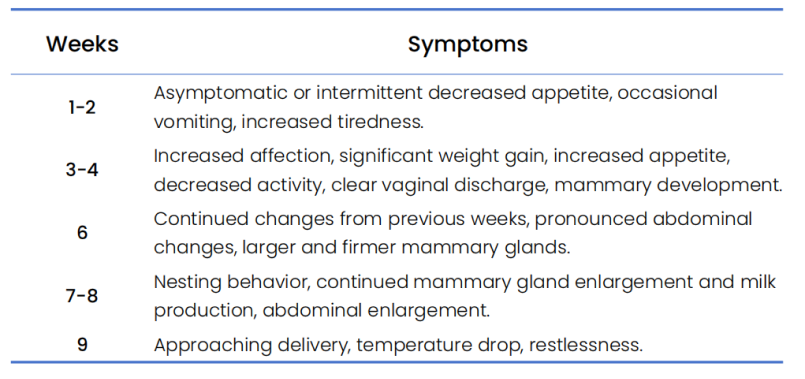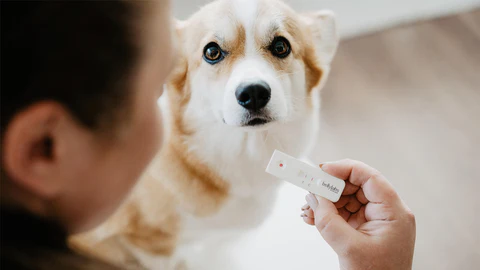In the field of pet care, early identification of signs of dog pregnancy is crucial to ensure the health of both the mother and the upcoming puppies.
Dog pregnancy is an exciting process that requires careful care. Identifying early signs of pregnancy can help pet owners provide the best care for the dog and the upcoming puppies. Early signs of pregnancy may include behavioral and physical changes.

Increased appetite: Pregnant dogs may experience an increase in appetite as their bodies require extra energy to support the development of the fetus.
Becoming more affectionate or irritable: Pregnant dogs may become more affectionate, seeking more attention and petting, and they may also become more irritable or protective.
Mammary gland swelling: Within a few weeks of pregnancy, a dog's mammary glands may begin to swell, and the nipples may become more prominent.
Gradual abdominal enlargement: As the fetus grows, a dog's abdomen will gradually enlarge, which usually becomes more noticeable after the fourth week of pregnancy.

- 1-2 weeks: Your dog may be asymptomatic or have intermittent decreased appetite, occasional vomiting; may be more tired than usual.
- 3-4 weeks: Your dog may display more affectionate behavior towards you; significant weight gain, increased appetite; may become less active; clear vaginal discharge and mammary development.
- 6 weeks: Continuing the changes from the previous weeks, abdominal changes become more pronounced, and mammary glands become larger and firmer.
- 7-8 weeks: Your dog may exhibit nesting behavior, such as dragging blankets to a safe place and rearranging pillows; mammary glands continue to enlarge and may produce milk; abdominal enlargement.
- 9 weeks: Approaching delivery; your dog's temperature may drop; it may appear restless.
Determining whether a dog is pregnant can be done in several ways, including ultrasound examination, X-ray examination, and blood tests.
Ultrasound examination is a non-invasive detection method that can detect the fetal heartbeat from the second to the third week of pregnancy. This method is safe and painless and is a commonly used detection method by veterinarians.
X-ray examination is usually performed in the late stages of pregnancy and can provide detailed information about the number and position of the fetuses. However, X-ray radiation may pose risks to early fetuses, so it is not recommended for use in the early stages of pregnancy.
The RLN blood test is an early pregnancy detection method that confirms pregnancy by measuring the level of relaxin hormone in a dog's blood. This test is usually performed 22 days after mating and has a high accuracy rate.
- Ultrasound examination: Advantages are safe, painless, and can observe the development of the fetus in real-time; disadvantages requires professional equipment and technical personnel.
- X-ray examination: Advantages can provide detailed fetal information; disadvantages radiation may be harmful to early fetuses.
- Relaxin (RLN) Rapid Test: Advantages are early and accurate; disadvantages require blood sample collection, and may require assistance from a veterinarian.
A dog's pregnancy period is typically 63 days but can vary between 57 to 65 days. Understanding the stages of a dog's pregnancy is crucial for early identification and monitoring.
- 1 week: Fertilized eggs begin to move in the fallopian tubes.
- 2 weeks: Fertilized eggs implant in the uterus.
- 3-4 weeks: Fetuses begin to develop, and heartbeats can be detected through ultrasound examination.
- 5-8 weeks: Fetuses develop rapidly, and a dog's abdomen noticeably enlarges.
Two to three weeks after a dog's estrus cycle is a critical period for monitoring signs of pregnancy. At this time, a dog's mammary glands may begin to swell, and the abdomen may gradually enlarge.
The Canine Pregnancy Relaxin (RLN) Rapid Test is a home pregnancy test that confirms pregnancy by detecting the relaxin hormone in a dog's blood.

- Sample collection: Requires blood sample collection from the dog, usually done at a veterinary clinic.
- Add sample: Holding the provided pipette vertically, add two drops of sample to the test well. Check that the sample has fully absorbed into the membrane. Remove the cap from the buffer bottle, hold it vertically, and add two drops of buffer to the test well.
- Interpreting results: Test results are usually displayed within 10 to 15 minutes, and a positive result indicates pregnancy.
If the test result is uncertain or you have any questions, it is recommended to contact a professional veterinarian for further examination and consultation.
The Canine Pregnancy Relaxin (RLN) Rapid Test is known for its high accuracy, but it is also important to understand the factors that affect the accuracy of the test.
RLN blood test: High accuracy, but requires blood sample collection.
Urine test: Easy to operate, but may have lower accuracy.
Test timing: Testing in the early stages of pregnancy may result in false negative results.
Sample handling: The way the sample is handled and stored may affect the test results.
Many Relaxin (RLN) Rapid Tests on the market have high accuracy, such as the tashkin™ Canine Pregnancy Relaxin (RLN) Rapid Test, which has an accuracy of >99%.
Monitoring the progress of a dog's pregnancy is crucial to ensure the health of the mother and the fetus.
Weight monitoring: Regularly weigh to ensure reasonable weight gain in dogs.
Nutrition management: Provide a high-calorie, balanced diet.
Behavioral observation: Pay attention to changes in the dog's behavior, such as appetite and activity level.
Regular veterinary check-ups: Regular veterinary check-ups can ensure the health of the dog and the fetus and promptly identify and address any potential issues.

Postpartum care is equally important, requiring proper nutrition and care for the dog.
High-calorie diet: Postpartum dogs need extra calories to recover strength and produce milk.
Nursing care: Closely monitor the health of the dog and puppies to ensure there are no complications.
Veterinary examination: If the dog shows any abnormal symptoms, contact a veterinarian immediately.
Consider spaying: To control the number of pets and prevent future health problems, consider spaying the dog.
Early identification and monitoring of dog pregnancy are crucial to ensure health throughout the entire pregnancy period. Early detection can ensure that pets receive the best care.








